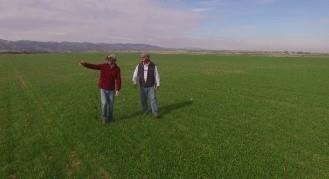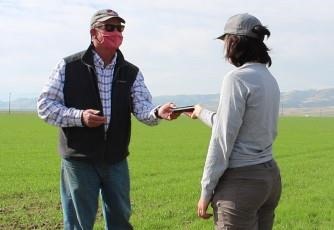By Mike Hsu
Growers in California grapple with plenty of climate uncertainty – but a new set of tools can help wheat farmers make crucial fertilizer decisions with more precision and confidence.
An interactive website integrates these tools – developed or adapted by researchers at the University of California, Davis and University of California Cooperative Extension – that provide farmers with recommendations for applying nitrogen fertilizers, specific to their own sites and conditions.

UCCE advisor Konrad Mathesius (left) talks with wheat grower Fritz Durst at a demonstration site in the Sacramento Valley. Photo by Mark Lundy
“The system is made for being flexible, for being reactive – and not having a cookie-cutter approach, year-in and year-out, because the weather is not cookie-cutter, year-in and year-out,” said Mark Lundy, UC Cooperative Extension specialist in the UC Davis Department of Plant Sciences.
While factoring in those weather variables, the management tool also draws data from two indicators of nitrogen sufficiency or deficiency: the results of a soil nitrate quick test (a simple test previously used in vegetable crop systems along the coast), and comparisons of plant health in the broader field to that in a “nitrogen-rich reference zone” (a practice originally developed in the Midwest).
Using them in tandem, in the context of California wheat growing, is a novel approach. In a Nov. 4 webinar, Lundy will introduce the use of the nitrogen-rich reference zone, a small area in a field where extra fertilizer is added at the beginning of the season.
“This project is a unique example of digital agriculture at work in an applied setting,” he explained. “We are integrating ‘big data' sources like site-specific soil and weather data, as well as satellite, drone and other sensor measurements into an interactive web interface. This allows users to receive straightforward yet highly customized recommendations from somewhat complex agronomic models.”

UC Davis researcher Taylor Nelsen (right) shares information provided by the Nitrogen Fertilizer Management Tool for California Wheat with grower Fritz Durst. Photo by Mark Lundy
Since 2019, agronomists from UC Davis and UCCE have been testing these tools in real-world conditions, with support from the California Department of Food and Agriculture's Fertilizer Research and Education Program and a Natural Resources Conservation Service Conservation Innovation Grant.
The team conducted 11 on-farm demonstrations in fields representing a wide range of agroecosystems, including the Sacramento Valley, San Joaquin Valley, Delta region, and Tulelake Basin.
Fritz Durst, a western Yolo County-based grower who participated in one of the case studies, said that the process of gathering the data was “actually pretty simple” and the tool “eliminates much of the guesswork” for managing nitrogen fertilizers.
“This tool is extremely helpful for me to make decisions about the most efficient and cost-effective method for applying nitrogen to my wheat,” Durst said.
In addition to potentially increasing crop productivity and farmer net-income, the tool can benefit the environment by reducing the amount of nitrate leaching from fertilizer applications, according to Lundy.
“It's not only trying to say how much fertilizer to put down, sometimes it's trying to confirm you don't really need any fertilizer,” he said.
Source : ucanr.edu